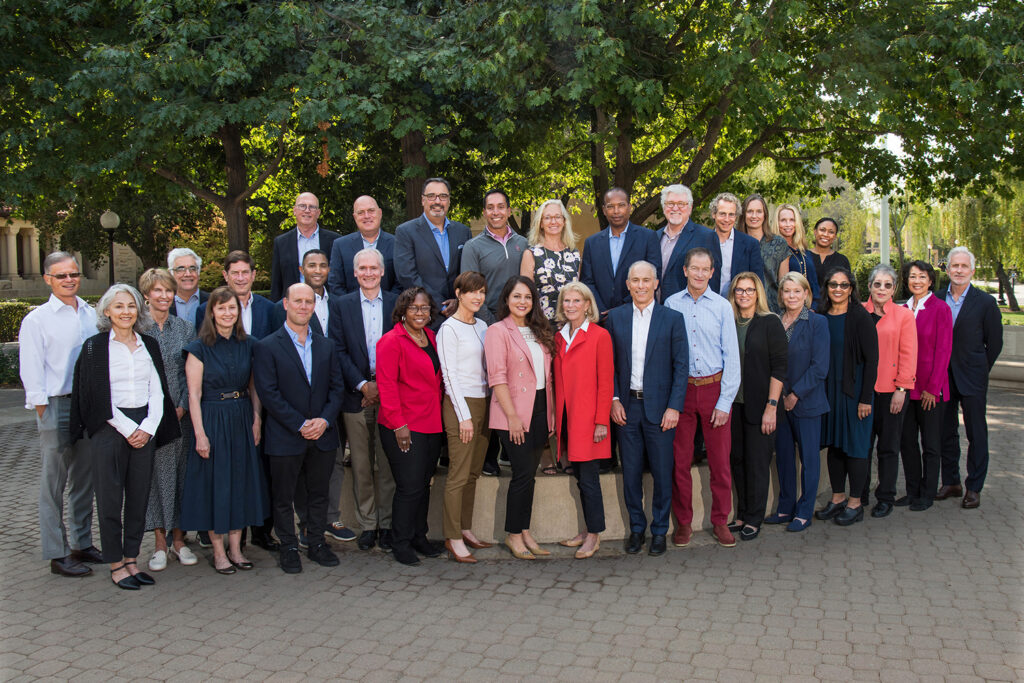Stanford’s Board of Trustees holds first meeting of the 2021-22 academic year
At its first meeting of the 2021-2022 academic year, Stanford’s Board of Trustees moved forward several building projects and received updates on how the university is raising its sights after the challenging beginning of the pandemic.
After a year during which the Stanford community largely focused inward as it coped with the pandemic, there is now opportunity to raise the sights of our community toward a brighter future, President Marc Tessier-Lavigne told the Board of Trustees this week.

The Stanford Board of Trustees gathers for a group photo on campus on Oct. 4, 2021. (Image credit: Steve Castillo Photography)
The board gathered on campus on Oct. 4 and 5 for its first in-person meeting of the 2021-2022 academic year, learning more about how the university is progressing after such a challenging period and what leadership prioritizes going forward.
In Jerry Yang’s first meeting as chair since his January election to the position, the board also moved several building projects forward, among other orders of business.
Returning to campus and advancing priorities
Yang told the board that the energy on campus now is palpable, giving a true sense of renewal.
Tessier-Lavigne echoed this sentiment, describing the joy he has sensed among students, faculty and staff as the campus community has returned, and expressing his optimism for the year ahead – notwithstanding continued difficulties caused by the pandemic.
Tessier-Lavigne discussed a range of priorities for the upcoming year, as the university returns to more normal operations and works to advance institutional priorities. Among them are fundraising for the schools, including the new school focused on climate and sustainability, and for initiatives that have come out of the long-range vision.
Externally, the university also will be working to tackle issues at the national level, including those related to immigration and visas, the nation’s approach to foreign influence on research and funding for research, Tessier-Lavigne said. On the regional level, Stanford will continue to engage with local communities through healthcare and the life sciences, the arts and work with local schools, among other efforts, he said.
Community renewal also will be an important priority for the year, Tessier-Lavigne said, as the university works to advance diversity, equity, access and inclusion efforts and also develop and refine a flexible workforce model for staff.
Provost Persis Drell provided the trustees with a picture of how Stanford has prepared for return to in-person living and learning as well as rebuilding community. Protocols have included vaccination requirements, entry testing, ongoing surveillance testing and face coverings required for indoors and recommended for crowded outdoor settings.
COVID-19 positivity rates have remained low and manageable at the university over the last couple months, she said.
Drell also discussed the need to address particular pressures some faculty have experienced during the pandemic and is looking at more targeted intervention for those in need of support.
Sarah Church, vice provost for undergraduate education, also provided information to trustees on the impact of first-year student enrollment, which is the largest frosh class in Stanford’s history. Special activities have been held or planned for each class as part of the community rebuilding efforts, and several in-person programs have returned, such as the Leland Scholars Program, Arts Intensive and Bing Overseas Studies Program, she said.
Going forward in shaping the undergraduate experience, she also discussed fundraising and next steps for the Res-X initiative and Stanford’s new Civic, Liberal and Global Education first-year requirement, otherwise known as COLLEGE.
During the two-day meeting, the trustees also fanned out across the campus to meet in small groups with Stanford deans and vice provosts to learn the latest about what is happening in different parts of the university and gain direct insight into their priorities and challenges.
Building and other approvals
This week, the board provided design approval for a proposed facility that would house a new Emergency Operations Center as well as a replacement Electronic Communications Hub in the Bonair Corporation Yard near Bonair Siding Road and Pampas Lane. It will come back to the board for construction approval next year.
The Board of Trustees also approved design and construction for the Stanford Research Computing Facility – Module 2 project being built to meet research computing needs for the university and the SLAC National Accelerator Laboratory.
The facility is a planned expansion of the existing Stanford Research Computing Facility Module 1. Construction is expected to begin this year.
The board additionally approved construction for renovations at 3172 Porter Drive to provide space for School of Medicine programs. Construction of this project is also expected to commence this year.